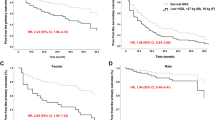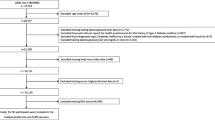Abstract
Skeletal muscle is important in insulin-stimulated glucose uptake. Sarcopenia is, therefore, a possible risk factor for insulin resistance. Currently, different diagnostic criteria for sarcopenia include low muscle mass, muscle strength, and walking speed. We assessed these muscle characteristics in relation to insulin resistance in nondiabetics. This cross-sectional study included 301 nondiabetics, mean age 65.9 years. Area under curve (AUC) calculations of insulin and glucose from a 2-h oral glucose tolerance test (OGTT) and homeostasis model assessment of insulin resistance (HOMA-IR) were used as measures of insulin resistance. Muscle characteristics were relative muscle mass (total or appendicular lean mass (ALM) as percentage of body mass), absolute muscle mass (ALM/height2 and total lean mass), handgrip strength, and walking speed. All muscle characteristics were standardized and analyzed in linear regression models, stratified by gender. For both males and females, relative muscle mass was inversely associated with AUC insulin, AUC glucose, and HOMA-IR (ALM percentage all p ≤ 0.004). Absolute muscle mass was positively associated with AUC insulin and HOMA-IR (ALM/height2 all p < 0.001) but not with AUC glucose. Adjustments for fat mass attenuated aforementioned associations. There were no associations between handgrip strength and insulin resistance. Walking speed was inversely associated with AUC insulin in males (p = 0.032). The association between muscle characteristics and insulin resistance was strongest for relative muscle mass. Diagnostic criteria for sarcopenia relate differently to insulin resistance. The role of muscle tissue as an internal glucose-regulating organ is better reflected by relative muscle mass than by absolute muscle mass, muscle strength, or walking speed.

Similar content being viewed by others
References
Abdul-Ghani MA, Matsuda M, Balas B, DeFronzo RA (2007) Muscle and liver insulin resistance indexes derived from the oral glucose tolerance test. Diabetes Care 30:89–94
Aleman H, Esparza J, Ramirez FA, Astiazaran H, Payette H (2011) Longitudinal evidence on the association between interleukin-6 and C-reactive protein with the loss of total appendicular skeletal muscle in free-living older men and women. Age Ageing 40:469–475
Antuna-Puente B, Disse E, Rabasa-Lhoret R, Laville M, Capeau J, Bastard JP (2011) How can we measure insulin sensitivity/resistance? Diabetes Metab 37:179–188
Barzilay JI, Cotsonis GA, Walston J, Schwartz AV, Satterfield S, Miljkovic I et al (2009) Insulin resistance is associated with decreased quadriceps muscle strength in nondiabetic adults aged > or =70 years. Diabetes Care 32:736–738
Baumgartner RN, Koehler KM, Gallagher D, Romero L, Heymsfield SB, Ross RR et al (1998) Epidemiology of sarcopenia among the elderly in New Mexico. Am J Epidemiol 147:755–763
Bijlsma AY, Meskers CG, Ling CH, Narici M, Kurrle SE, Cameron ID et al. (2012) Defining sarcopenia: the impact of different diagnostic criteria on the prevalence of sarcopenia in a large middle aged cohort. Age (Dordr.)
Bunout D, de la Maza MP, Barrera G, Leiva L, Hirsch S (2011) Association between sarcopenia and mortality in healthy older people. Australas J Ageing 30:89–92
Burns JM, Johnson DK, Watts A, Swerdlow RH, Brooks WM (2010) Reduced lean mass in early Alzheimer disease and its association with brain atrophy. Arch Neurol 67:428–433
Corcoran MP, Lamon-Fava S, Fielding RA (2007) Skeletal muscle lipid deposition and insulin resistance: effect of dietary fatty acids and exercise. Am J Clin Nutr 85:662–677
Cruz-Jentoft AJ, Baeyens JP, Bauer JM, Boirie Y, Cederholm T, Landi F et al. (2010) Sarcopenia: European consensus on definition and diagnosis: report of the European working group on sarcopenia in older people Age Ageing
Despres JP, Lemieux I, Prud'homme D (2001) Treatment of obesity: need to focus on high risk abdominally obese patients. BMJ 322:716–720
Estrada M, Kleppinger A, Judge JO, Walsh SJ, Kuchel GA (2007) Functional impact of relative versus absolute sarcopenia in healthy older women. J Am Geriatr Soc 55:1712–1719
Fielding RA, Vellas B, Evans WJ, Bhasin S, Morley JE, Newman AB et al (2011) Sarcopenia: an undiagnosed condition in older adults. Current consensus definition: prevalence, etiology, and consequences. International working group on sarcopenia. J Am Med Dir Assoc 12:249–256
Guillet C, Boirie Y (2005) Insulin resistance: a contributing factor to age-related muscle mass loss? Diabetes Metab 31 Spec No 2: 5S20-5S26
Guralnik JM, Ferrucci L, Pieper CF, Leveille SG, Markides KS, Ostir GV et al (2000) Lower extremity function and subsequent disability: consistency across studies, predictive models, and value of gait speed alone compared with the short physical performance battery. J Gerontol A Biol Sci Med Sci 55:M221–M231
Helmrich SP, Ragland DR, Leung RW, Paffenbarger RS Jr (1991) Physical activity and reduced occurrence of non-insulin-dependent diabetes mellitus. N Engl J Med 325:147–152
Janssen I, Baumgartner RN, Ross R, Rosenberg IH, Roubenoff R (2004) Skeletal muscle cutpoints associated with elevated physical disability risk in older men and women. Am J Epidemiol 159:413–421
Janssen I, Heymsfield SB, Ross R (2002) Low relative skeletal muscle mass (sarcopenia) in older persons is associated with functional impairment and physical disability. J Am Geriatr Soc 50:889–896
Kalyani RR, Metter EJ, Ramachandran R, Chia CW, Saudek CD, Ferrucci L (2011) Glucose and insulin measurements from the oral glucose tolerance test and relationship to muscle mass J Gerontol A Biol Sci Med Sci
Kuo CK, Lin LY, Yu YH, Wu KH, Kuo HK (2009) Inverse association between insulin resistance and gait speed in nondiabetic older men: results from the US National Health and Nutrition Examination Survey (NHANES) 1999–2002. BMC.Geriatr. 9: 49
Lauretani F, Russo CR, Bandinelli S, Bartali B, Cavazzini C, Di IA et al (2003) Age-associated changes in skeletal muscles and their effect on mobility: an operational diagnosis of sarcopenia. J Appl Physiol 95:1851–1860
Lazarus R, Sparrow D, Weiss ST (1997) Handgrip strength and insulin levels: cross-sectional and prospective associations in the normative aging study. Metabolism 46:1266–1269
Lee CG, Boyko EJ, Strotmeyer ES, Lewis CE, Cawthon PM, Hoffman AR et al (2011) Association between insulin resistance and lean mass loss and fat mass gain in older men without diabetes mellitus. J Am Geriatr Soc 59:1217–1224
Ling CH, de Craen AJ, Slagboom PE, Gunn DA, Stokkel MP, Westendorp RG et al. (2011) Accuracy of direct segmental multi-frequency bioimpedance analysis in the assessment of total body and segmental body composition in middle-aged adult population Clin Nutr
Matthews DR, Hosker JP, Rudenski AS, Naylor BA, Treacher DF, Turner RC (1985) Homeostasis model assessment: insulin resistance and beta-cell function from fasting plasma glucose and insulin concentrations in man. Diabetologia 28:412–419
Melton LJ III, Khosla S, Crowson CS, O’Connor MK, O’Fallon WM, Riggs BL (2000) Epidemiology of sarcopenia. J Am Geriatr Soc 48:625–630
Newman AB, Kupelian V, Visser M, Simonsick E, Goodpaster B, Nevitt M et al (2003) Sarcopenia: alternative definitions and associations with lower extremity function. J Am Geriatr Soc 51:1602–1609
Park SW, Goodpaster BH, Lee JS, Kuller LH, Boudreau R, de Rekeneire N et al (2009) Excessive loss of skeletal muscle mass in older adults with type 2 diabetes. Diabetes Care 32:1993–1997
Peppa M, Koliaki C, Nikolopoulos P, Raptis SA (2010) Skeletal muscle insulin resistance in endocrine disease. J Biomed Biotechnol 2010:527850
Rosenberg IH (1997) Sarcopenia: origins and clinical relevance. J Nutr 127:990S–991S
Rozing MP, Westendorp RG, de Craen AJ, Frolich M, de Goeij MC, Heijmans BT et al (2010) Favorable glucose tolerance and lower prevalence of metabolic syndrome in offspring without diabetes mellitus of nonagenarian siblings: the Leiden Longevity Study. J Am Geriatr Soc 58:564–569
Sayer AA, Dennison EM, Syddall HE, Gilbody HJ, Phillips DI, Cooper C (2005) Type 2 diabetes, muscle strength, and impaired physical function: the tip of the iceberg? Diabetes Care 28:2541–2542
Schaap LA, Pluijm SM, Deeg DJ, Harris TB, Kritchevsky SB, Newman AB et al (2009) Higher inflammatory marker levels in older persons: associations with 5-year change in muscle mass and muscle strength. J Gerontol A Biol Sci Med Sci 64:1183–1189
Schoenmaker M, de Craen AJ, de Meijer PH, Beekman M, Blauw GJ, Slagboom PE et al (2006) Evidence of genetic enrichment for exceptional survival using a family approach: the Leiden Longevity Study. Eur J Hum Genet 14:79–84
Srikanthan P, Karlamangla AS (2011) Relative muscle mass is inversely associated with insulin resistance and prediabetes. Findings from the third national health and nutrition examination survey. J Clin Endocrinol Metab 96:2898–2903
Takeuchi M, Kanazawa A, Suzuki M, Hasegawa M, Kimura Y, Kodama K et al (2000) Evaluation of factors during OGTT to correlate insulin resistance in non-diabetic subjects. Endocr J 47:535–542
Westendorp RG, van Heemst D, Rozing MP, Frolich M, Mooijaart SP, Blauw GJ et al (2009) Nonagenarian siblings and their offspring display lower risk of mortality and morbidity than sporadic nonagenarians: the Leiden Longevity Study. J Am Geriatr Soc 57:1634–1637
Wilson PW, Anderson KM, Kannel WB (1986) Epidemiology of diabetes mellitus in the elderly. The Framingham Study. Am J Med 80:3–9
Acknowledgments
This study was supported by an unrestricted grant from the Netherlands Organization of Scientific Research (ZonMw); the Ministry of Health, Welfare and Sports; the Netherlands Genomics Initiative/Netherlands Organization for Scientific Research (NGI/NWO; 05040202 and 050-060-810 Netherlands Consortium for Healthy Aging (NCHA)); the European Commission funded project MYOAGE (FP7, HEALTH-2007-2.4.5-10); and Switchbox (FP7, Health-F2-2010-259772).
Author information
Authors and Affiliations
Corresponding author
About this article
Cite this article
Bijlsma, A.Y., Meskers, C.G.M., van Heemst, D. et al. Diagnostic criteria for sarcopenia relate differently to insulin resistance. AGE 35, 2367–2375 (2013). https://doi.org/10.1007/s11357-013-9516-0
Received:
Accepted:
Published:
Issue Date:
DOI: https://doi.org/10.1007/s11357-013-9516-0




